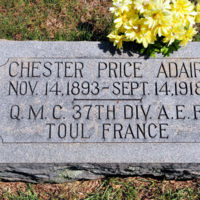Chester Price Adair
Dublin Core
Title
Chester Price Adair
Subject
Chester Price Adair
Description
Chester P Adair was a private with the U.S. Army and served with the American expeditionary forces during World War I. He contracted pneumonia while in Toule, France and died in a French hospital on September 18, 1918 at the age of 25. He was the son of James Thomas Adair and Fannie Orilla Adair and had two brothers named James Thomas and Luther Carlton.
Plot WH123
Plot WH123
Creator
Jillian Girardeau
Coverage
Chester Price Adair was born on November 14, 1893 in Clarke County, Georgia and died in Toule, France on September 14, 1918. Following his death, Adair’s body was sent back to his home and he is now laid to rest at the historic Oconee Hill Cemetery in Athens, Georgia along with several of his family members.
Chester was born to Joseph Thomas Adair, a railway engineer, and Fannie Orilla Richey Adair, a housewife, on November 14, 1893. He had two younger brothers- James Thomas and Luther Carlton. Chester was described as having a reserved and quiet disposition and was well-known and well-liked in the community. He and his family were members of the First Methodist Church and Chester had been a student at the University of Georgia, graduating with the Class of 1915. Prior to his enlistment in the military, Adair worked in the construction department of the very successful American Bell Telephone Company, occasionally paying visits to his parents in Athens. In 1917, Adair was drafted to serve in World War I as a result of the Selective Service Act. He enlisted on December 12, 1917 and was sent to Fort Oglethorpe and then to Camp Johnson in Jacksonville. From Camp Johnson, Adair was sent overseas in June 1918.
Adair served with the American expeditionary forces during his time overseas. In Toule, France, Adair contracted pneumonia as a result of a major pandemic and succumbed to his illness in a French hospital on September 14, 1918, at the age of twenty-four. His father was notified by telegram soon after his son’s death. Chester’s remains could not be interred in Athens for several years, however. Many American soldiers had been buried on French soil during the war, and the French were reluctant to allow the United States to remove the bodies for transport. They viewed the removal of the deceased as grim and distasteful. The French government later issued a ban on the transport of bodies for three years, stating that they needed to focus on rebuilding after the war, which had ended about two months after Chester’s death in 1918. It is likely that Chester was interred in an American cemetery in France prior to being transported back to his home. The ban was lifted in 1920 due to pressure by Americans. Chester’s body was first sent to New York, and then back to Athens for interment. The remains arrived on the afternoon of February 25, 1921 and services were held at First Methodist Church. Adair was buried in Oconee Hill Cemetery on February 27, 1921.
On May 30, 1922, an elaborate memorial ceremony was held at Oconee Hill Cemetery honoring all of the soldiers who had lost their lives during the war. The gates of the cemetery were decorated with flowers and wreaths and two American flags were unfurled, one of them being the flag that had accompanied Adair’s body back to Athens. Records state that Adair’s grave may have been left either unmarked or not properly marked for seven years after his burial. In 1928, an application for a military headstone was made in the name of the Athens Judge Horace M. Holden, and Adair’s grave was given a proper headstone.
While he did not have a profound impact on the Athens community as some of those who reside at Oconee Hill, Chester Adair serves as an example of the complexity behind even the most modest gravesites at cemeteries, and the importance of telling and making available the stories of all of the deceased at Oconee.
Works Cited
Athens Newspapers
http://athnewspapers.galileo.usg.edu/athnewspapers-j2k/view?docId=bookreader/ahd/ahd1922/ahd1922-0800.mets.xml;query=chester%20adair;brand=athnewspapers-j2k-brand#page/n0/mode/1up
http://athnewspapers.galileo.usg.edu/athnewspapers-j2k/view?docId=bookreader/adb/adb1917/adb1917-0936.mets.xml;query=chester%20adair;brand=athnewspapers-j2k-brand#page/n0/mode/1up
http://athnewspapers.galileo.usg.edu/athnewspapers-j2k/view?docId=bookreader/abw/abw1917/abw1917-0272.mets.xml;query=chester%20adair;brand=athnewspapers-j2k-brand#page/n0/mode/1up
http://athnewspapers.galileo.usg.edu/athnewspapers-j2k/view?docId=bookreader/adb/adb1921/adb1921-0151.mets.xml;query=chester%20adair;brand=athnewspapers-j2k-brand#page/1/mode/1up
http://athnewspapers.galileo.usg.edu/athnewspapers-j2k/view?docId=bookreader/abw/abw1921/abw1921-0055.mets.xml;query=chester%20adair;brand=athnewspapers-j2k-brand#page/1/mode/1up
General Information:
http://www.findagrave.com/cgi-bin/fg.cgi?page=gr&GSsr=41&GScid=35965&GRid=74160688&
http://www.historynet.com/rest-in-peace-bringing-home-u-s-war-dead.htm
https://virus.stanford.edu/uda/
Ancestry Documents
Military Headstone Application, 1928 - Chester P Adair
World War I Draft Registration Card - Chester P Adair
Collection
Citation
Jillian Girardeau, “Chester Price Adair,” Death and Human History in Athens, accessed September 8, 2025, https://digilab.libs.uga.edu/cemetery/items/show/17.
Embed
Copy the code below into your web page


